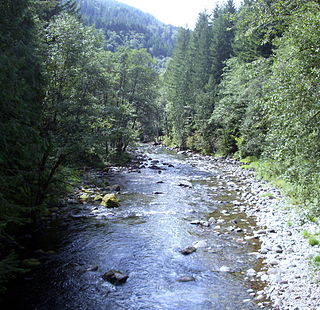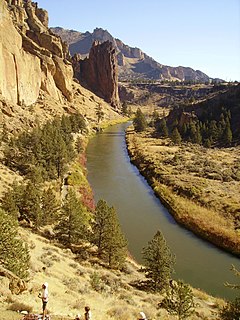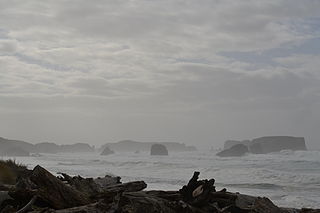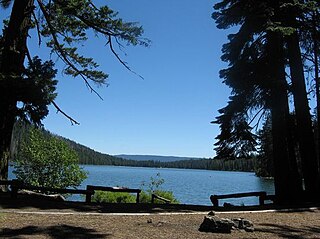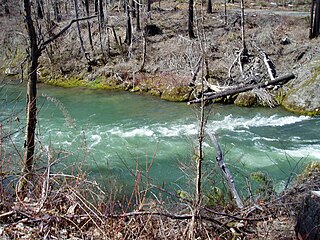| Little North Santiam River | |
| Name origin:For the Santiam people, a Kalapuya tribe that lived near the Santiam River until removal to the Grande Ronde Reservation in 1906. [1] | |
| Country | United States |
|---|---|
| State | Oregon |
| County | Marion |
| Source | confluence of Battle Ax and Opal creeks |
| - location | Cascade Range |
| - elevation | 2,085 ft (636 m) [2] |
| - coordinates | 44°50′48″N122°12′33″W / 44.84667°N 122.20917°W [3] |
| Mouth | North Santiam River |
| - location | near Mehama |
| - elevation | 619 ft (189 m) [3] |
| - coordinates | 44°47′05″N122°36′30″W / 44.78472°N 122.60833°W Coordinates: 44°47′05″N122°36′30″W / 44.78472°N 122.60833°W [3] |
| Length | 27 mi (43 km) [4] |
| Basin | 113 sq mi (293 km2) [4] |
| Discharge | |
| - average | 746 cu ft/s (21 m3/s) [4] |
The Little North Santiam River is a 27-mile (43 km) tributary of the North Santiam River in western Oregon in the United States. [4] It drains 113 square miles (290 km2) of the Cascade Range on the eastern side of the Willamette Valley east of Salem. [4]

The North Santiam River is a 92-mile (148 km) tributary of the Santiam River in western Oregon in the United States. It drains 766 square miles (1,980 km2) of the Cascade Range on the eastern side of the Willamette Valley east of Salem.

Oregon is a state in the Pacific Northwest region on the West Coast of the United States. The Columbia River delineates much of Oregon's northern boundary with Washington, while the Snake River delineates much of its eastern boundary with Idaho. The parallel 42° north delineates the southern boundary with California and Nevada. Oregon is one of only three states of the contiguous United States to have a coastline on the Pacific Ocean.

The Cascade Range or Cascades is a major mountain range of western North America, extending from southern British Columbia through Washington and Oregon to Northern California. It includes both non-volcanic mountains, such as the North Cascades, and the notable volcanoes known as the High Cascades. The small part of the range in British Columbia is referred to as the Canadian Cascades or, locally, as the Cascade Mountains. The latter term is also sometimes used by Washington residents to refer to the Washington section of the Cascades in addition to North Cascades, the more usual U.S. term, as in North Cascades National Park. The highest peak in the range is Mount Rainier in Washington at 14,411 feet (4,392 m).
Contents
The river begins in the Opal Creek Wilderness at the confluence of Battle Ax and Opal creeks in Willamette National Forest and flows generally west-southwest through forests within Marion County to meet the larger river near Mehama. [5] North Fork Road runs along the stream's lower reaches until it meets Forest Road 2209, which continues upstream to Opal Creek Trailhead. [4]

The Opal Creek Wilderness is a wilderness area located in the Willamette National Forest in the U.S. state of Oregon, on the border of the Mount Hood National Forest. It has the largest uncut watershed in Oregon.
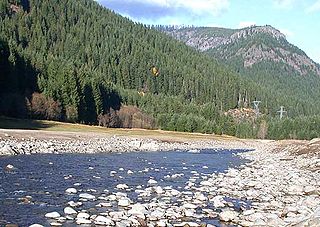
The Willamette National Forest is a National Forest located in the central portion of the Cascade Range of the U.S. state of Oregon. It comprises 1,678,031 acres (6,790.75 km2), making it one of the largest national forests. Over 380,000 acres are designated wilderness which include seven major mountain peaks. There are also several National Wild and Scenic Rivers within the forest. The forest is named for the Willamette River, which has its headwaters in the forest. The forest headquarters are located in the city of Springfield. There are local ranger district offices in McKenzie Bridge, Detroit, Sweet Home, and Westfir.

Marion County is a county located in the U.S. state of Oregon. The population was 315,335 at the 2010 census, making it the fifth-most populous county in Oregon. The county seat is Salem, the state capital. The county was originally named the Champooick District, after Champoeg, a meeting place on the Willamette River. On September 3, 1849, the territorial legislature renamed it in honor of Francis Marion, a Continental Army general from South Carolina who served in the American Revolutionary War.
Named tributaries from source to mouth are Opal, Battle Ax, Gold, Horn, Tincup, Cold, Stack, Cedar, and Little Cedar creeks. Then come Dry, Henline, Evans, Fawn, Elkhorn, Fish, Sinker, Moorehouse, and Big creeks. Further downstream are Cougar, Bear, Canyon, Kiel, Beaver, Jeeter, Cox, and Polly creeks. [5]

Elkhorn Creek is a 7.6-mile (12 km) long stream in Marion County, Oregon, United States. Its source is on the northern edge of the Willamette National Forest, about 3.5 miles (5.6 km) north of Big Cliff Reservoir. The creek flows mostly west, receiving Big Twelve Creek, Buckhorn Creek, and Buck Creek all from the south, and it enters the Little North Santiam River just south of Elkhorn Woods Park, about 5 miles (8.0 km) north of the city of Gates. The stream's valley is surrounded by the western Cascade foothills, covered with coniferous trees characteristic of the Pacific Northwest, and lined with red alders at the water's edge. The creek supports runs of rainbow and coastal cutthroat trout, as well as Pacific giant salamanders. On September 30, 1996, a 6.4-mile (10.3 km) portion of the stream, from the mouth nearly to the source, was protected as part of the National Wild and Scenic Rivers System.



